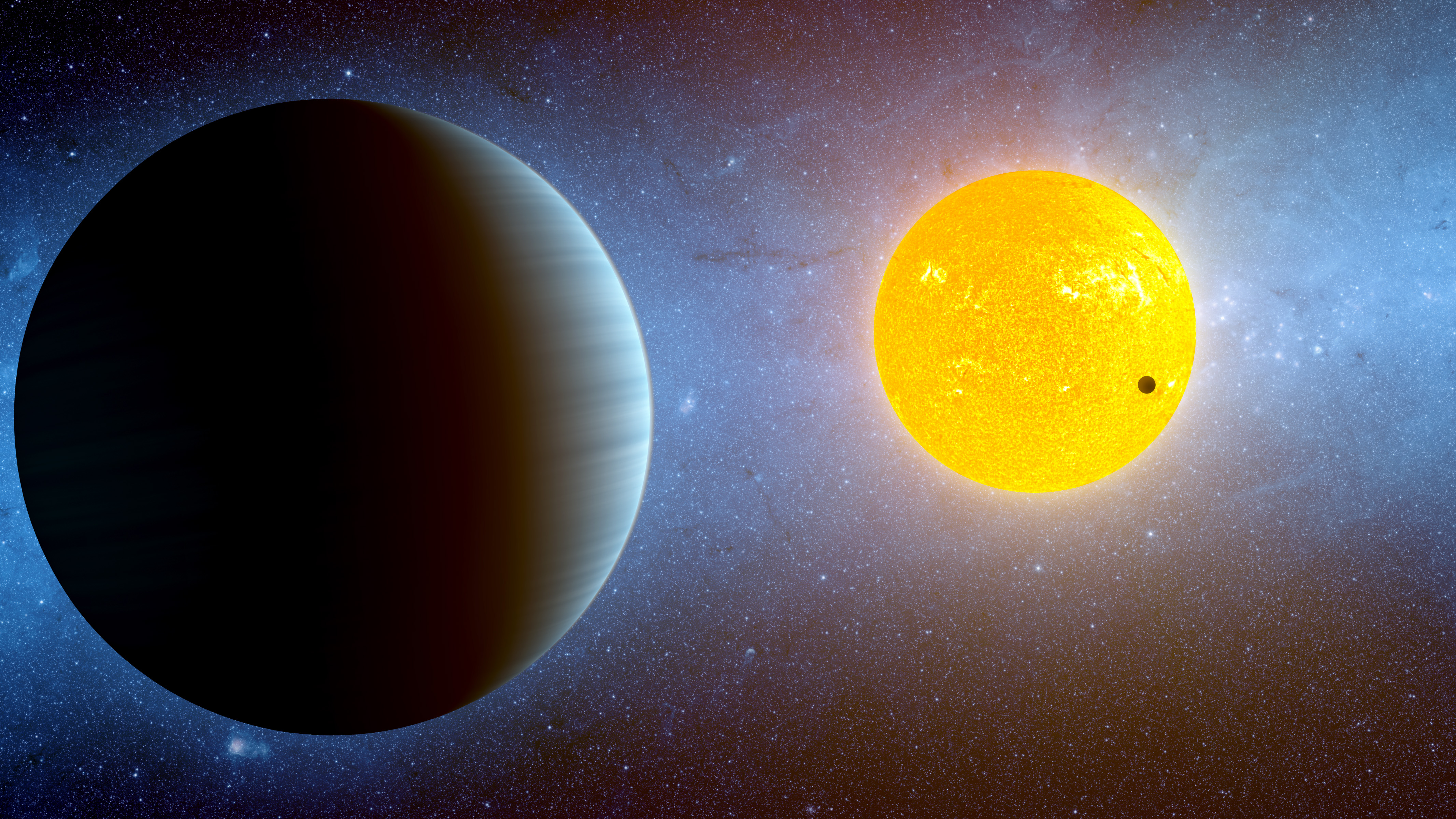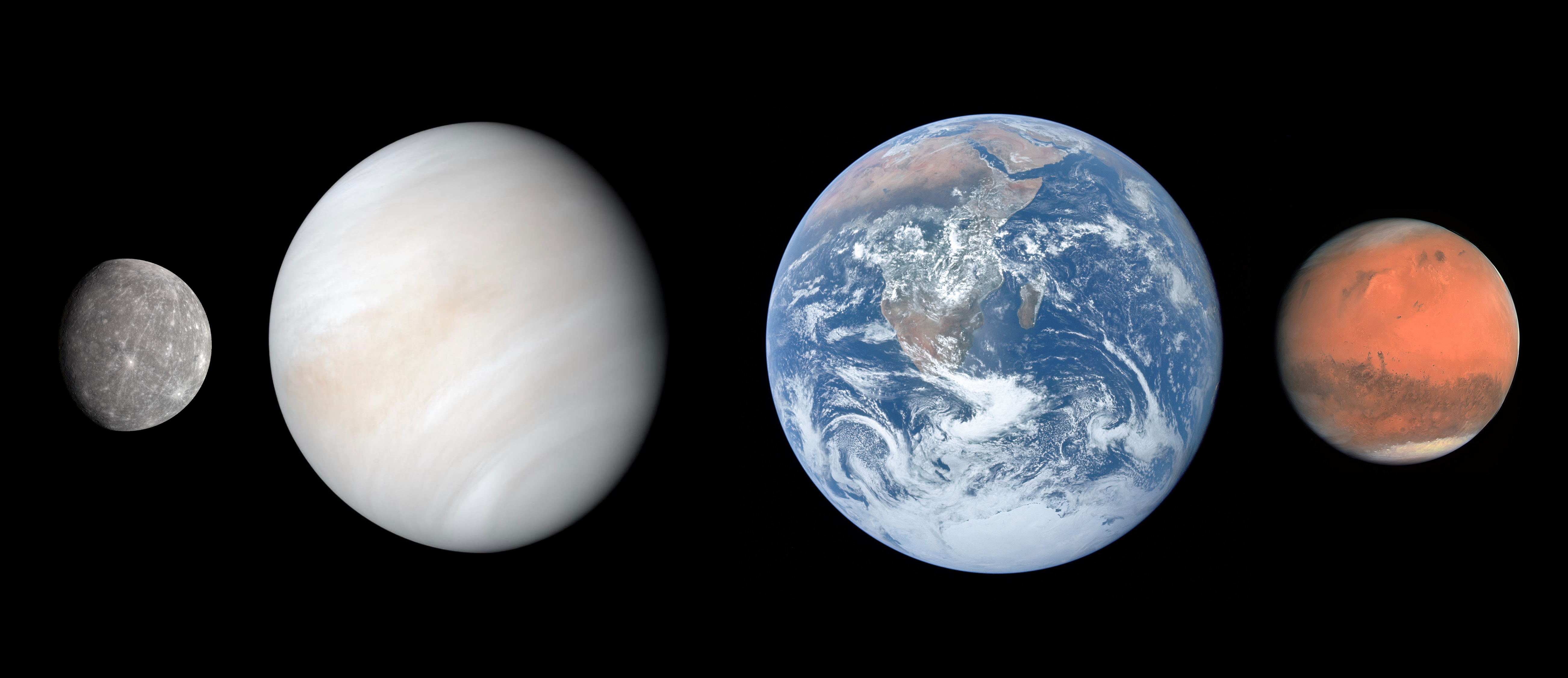|
Kepler-10b
Kepler-10b is the first confirmed terrestrial planet to have been discovered outside the Solar System by the Kepler Space Telescope. Discovered after several months of data collection during the course of the NASA-directed Kepler Mission, which aims to discover Earth-like planets crossing in front of their host stars, the planet's discovery was announced on January 10, 2011. Kepler-10b has a mass of 3.72±0.42 Earth masses and a radius of 1.47 Earth radii. However, it lies extremely close to its star, Kepler-10, and as a result is too hot to support life as we know it. Its existence was confirmed using measurements from the W.M. Keck Observatory in Hawaii. Nomenclature and history Kepler-10, the star that hosts Kepler-10b, is located 560 light-years from the Solar System in the Draco constellation. It is approximately the same size as the Sun, with an estimated age of 12 billion years. Planet Kepler-10b was the first planet to be discovered in the orbit of its star ... [...More Info...] [...Related Items...] OR: [Wikipedia] [Google] [Baidu] |
Kepler-10
Kepler-10, formerly known as KOI-72, is a Sun-like star in the constellation of Draco that lies 187 parsecs (608 light years) from Earth. Kepler-10 was targeted by NASA's Kepler spacecraft, as it was seen as the first star identified by the Kepler mission that could be a possible host to a small, transiting exoplanet. The star is slightly less massive, slightly larger, and slightly cooler than the Sun; at an estimated 10.4 billion years in age, Kepler-10 is almost 2.6 times the age of the Sun. Kepler-10 is host to a planetary system made up of at least two planets. Kepler-10b, the first undeniably rocky planet, was discovered in its orbit after eight months of observation and announced on January 10, 2011. The planet orbits its star closely, completing an orbit every 0.8 days, and has a density similar to that of iron. The second planet, Kepler-10c, was confirmed on May 23, 2011, based on follow-up observations by the Spitzer Space Telescope. The data shows it has an o ... [...More Info...] [...Related Items...] OR: [Wikipedia] [Google] [Baidu] |
Kepler-10c
Kepler-10c is an exoplanet orbiting the G-type star Kepler-10, located around 608 light-years away in Draco. Its discovery was announced by Kepler in May 2011, although it had been seen as a planetary candidate since January 2011, when Kepler-10b was discovered. The team confirmed the observation using data from NASA's Spitzer Space Telescope and a technique called BLENDER that ruled out most false positives. Kepler-10c was the third transiting planet to be confirmed statistically (based on probability rather than actual observation), after Kepler-9d and Kepler-11g. The Kepler team considers the statistical method that led to the discovery of Kepler-10c as what will be necessary to confirm many planets in Kepler's field of view. Kepler-10c orbits its host star every forty-five days at a quarter of the average distance between the Sun and Earth. Initial observations showed that it has a radius more than double that of Earth, and suggested a higher density, suggesting a mainly ro ... [...More Info...] [...Related Items...] OR: [Wikipedia] [Google] [Baidu] |
CoRoT-7b
CoRoT-7b (previously named CoRoT-Exo-7b) is an exoplanet orbiting the star CoRoT-7 in the constellation of Monoceros, from Earth. It was first detected photometrically by the French-led CoRoT mission and reported in February 2009. Until the announcement of Kepler-10b in January 2011, it was the smallest exoplanet to have its diameter measured, at 1.58 times that of the Earth (which would give it a volume 3.95 times Earth's) and the first potential extrasolar terrestrial planet to be found. The exoplanet has a very short orbital period, revolving around its host star in about 20 hours. Combination of the planet's diameter derived from transit data with the planet's mass derived from radial velocity measurements means that the density of CoRoT-7b is about the same as that of Earth; therefore, CoRoT-7b is a terrestrial planet like Earth and not a gas giant like Jupiter. The radial velocity observations of CoRoT-7 also detected a second super-Earth, CoRoT-7c, which has a mass 8.4 tim ... [...More Info...] [...Related Items...] OR: [Wikipedia] [Google] [Baidu] |
Terrestrial Planet
A terrestrial planet, telluric planet, or rocky planet, is a planet that is composed primarily of silicate rocks or metals. Within the Solar System, the terrestrial planets accepted by the IAU are the inner planets closest to the Sun: Mercury, Venus, Earth and Mars. Among astronomers who use the geophysical definition of a planet, two or three planetary-mass satellites – Earth's Moon, Io, and sometimes Europa – may also be considered terrestrial planets; and so may be the rocky protoplanet-asteroids Pallas and Vesta.Emily Lakdawalla et al.What Is A Planet?The Planetary Society, 21 April 2020 The terms "terrestrial planet" and "telluric planet" are derived from Latin words for Earth (''Terra'' and ''Tellus''), as these planets are, in terms of structure, ''Earth-like''. Terrestrial planets are generally studied by geologists, astronomers, and geophysicists. Terrestrial planets have a solid planetary surface, making them substantially different from the larger gaseous ... [...More Info...] [...Related Items...] OR: [Wikipedia] [Google] [Baidu] |
Lava-ocean Planet
A lava planet is a type of terrestrial planet, with a surface mostly or entirely covered by molten lava. Situations where such planets could exist include a young terrestrial planet just after its formation, a planet that has recently suffered a large collision event, or a planet orbiting very close to its star, causing intense irradiation and tidal forces. Factors and characteristics Lava planets would probably orbit extremely close to their parent star. In planets with eccentric orbits, the gravity from the nearby star would distort the planet periodically, with the resulting friction producing internal heat. This tidal heating could melt rocks into magma, which would then erupt through volcanoes. This would be similar to the Solar System moon Io, orbiting close to its parent Jupiter. Io is the most geologically active world in the Solar System, with hundreds of volcanic centres and extensive lava flows. Lava worlds orbiting extremely closely to the parent star may p ... [...More Info...] [...Related Items...] OR: [Wikipedia] [Google] [Baidu] |
Kepler-4b
Kepler-4b, initially known as KOI 7.01, is an extrasolar planet first detected as a transit by the Kepler spacecraft. Its radius and mass are similar to that of Neptune; however, due to its proximity to its host star, it is substantially hotter than any planet in the Solar System. The planet's discovery was announced on January 4, 2010, in Washington, D.C., along with four other planets that were initially detected by the Kepler spacecraft and subsequently confirmed by telescopes at the W.M. Keck Observatory. Nomenclature and history Kepler-4b was named because it was the first planet discovered in the orbit of its star, Kepler-4. The star was, in turn, named for the Kepler Mission, a NASA satellite whose purpose is to discover Earth-like planets in a section of the sky between constellations Cygnus and Lyra using the transit method. Using this method, Kepler notes small and steady decreases in a star's brightness that are measured as a planet crosses in front of it. Init ... [...More Info...] [...Related Items...] OR: [Wikipedia] [Google] [Baidu] |
Draco (constellation)
Draco is a constellation in the far northern sky. Its name is Latin for dragon. It was one of the 48 constellations listed by the 2nd century astronomer Ptolemy, and remains one of the 88 modern constellations today. The north pole of the ecliptic is in Draco. Draco is circumpolar from northern latitudes. There it is never setting and therefore can be seen all year. Features Stars Thuban (α Draconis) was the northern pole star from 3942 BC, when it moved farther north than Theta Boötis, until 1793 BC. The Egyptian Pyramids were designed to have one side facing north, with an entrance passage geometrically aligned so that Thuban would be visible at night. Due to the effects of precession, it would again be the pole star around the year AD 21000. It is a blue-white giant star of magnitude 3.7, 309 light-years from Earth. The traditional name of Alpha Draconis, Thuban, means "head of the serpent". There are three stars under magnitude 3 in Draco. The brighter of ... [...More Info...] [...Related Items...] OR: [Wikipedia] [Google] [Baidu] |
USA Today
''USA Today'' (stylized in all uppercase) is an American daily middle-market newspaper and news broadcasting company. Founded by Al Neuharth on September 15, 1982, the newspaper operates from Gannett's corporate headquarters in Tysons, Virginia. Its newspaper is printed at 37 sites across the United States and at five additional sites internationally. The paper's dynamic design influenced the style of local, regional, and national newspapers worldwide through its use of concise reports, colorized images, informational graphics, and inclusion of popular culture stories, among other distinct features. With an average print circulation of 159,233 as of 2022, a digital-only subscriber base of 504,000 as of 2019, and an approximate daily readership of 2.6 million, ''USA Today'' is ranked as the first by circulation on the list of newspapers in the United States. It has been shown to maintain a generally center-left audience, in regards to political persuasion. ''USA Today ... [...More Info...] [...Related Items...] OR: [Wikipedia] [Google] [Baidu] |
Doppler Shift
The Doppler effect or Doppler shift (or simply Doppler, when in context) is the change in frequency of a wave in relation to an observer who is moving relative to the wave source. It is named after the Austrian physicist Christian Doppler, who described the phenomenon in 1842. A common example of Doppler shift is the change of pitch heard when a vehicle sounding a horn approaches and recedes from an observer. Compared to the emitted frequency, the received frequency is higher during the approach, identical at the instant of passing by, and lower during the recession. The reason for the Doppler effect is that when the source of the waves is moving towards the observer, each successive wave crest is emitted from a position closer to the observer than the crest of the previous wave. Therefore, each wave takes slightly less time to reach the observer than the previous wave. Hence, the time between the arrivals of successive wave crests at the observer is reduced, causing an inc ... [...More Info...] [...Related Items...] OR: [Wikipedia] [Google] [Baidu] |
Blast Furnace
A blast furnace is a type of metallurgical furnace used for smelting to produce industrial metals, generally pig iron, but also others such as lead or copper. ''Blast'' refers to the combustion air being "forced" or supplied above atmospheric pressure. In a blast furnace, fuel (coke (fuel), coke), ores, and Flux (metallurgy), flux (limestone) are continuously supplied through the top of the furnace, while a hot blast of air (sometimes with oxygen enrichment) is blown into the lower section of the furnace through a series of pipes called tuyeres, so that the #Process engineering and chemistry, chemical reactions take place throughout the furnace as the material falls downward. The end products are usually molten metal and slag phases tapped from the bottom, and waste gases (flue gas) exiting from the top of the furnace. The downward flow of the ore along with the flux in contact with an upflow of hot, carbon monoxide-rich combustion gases is a countercurrent exchange and chemical ... [...More Info...] [...Related Items...] OR: [Wikipedia] [Google] [Baidu] |
Gram
The gram (originally gramme; SI unit symbol g) is a unit of mass in the International System of Units (SI) equal to one one thousandth of a kilogram. Originally defined as of 1795 as "the absolute weight of a volume of pure water equal to the cube of the hundredth part of a metre melting ice", the defining temperature (~0 °C) was later changed to 4 °C, the temperature of maximum density of water. However, by the late 19th century, there was an effort to make the Base unit (measurement), base unit the kilogram and the gram a derived unit. In 1960, the new International System of Units defined a ''gram'' as one one-thousandth of a kilogram (i.e., one gram is Scientific notation, 1×10−3 kg). The kilogram, as of 2019, is defined by the International Bureau of Weights and Measures from the fixed numerical value of the Planck constant (), which is kg⋅m2⋅s−1. Official SI symbol The only unit symbol for gram that is recognised by the International S ... [...More Info...] [...Related Items...] OR: [Wikipedia] [Google] [Baidu] |


.jpg)






.jpg)